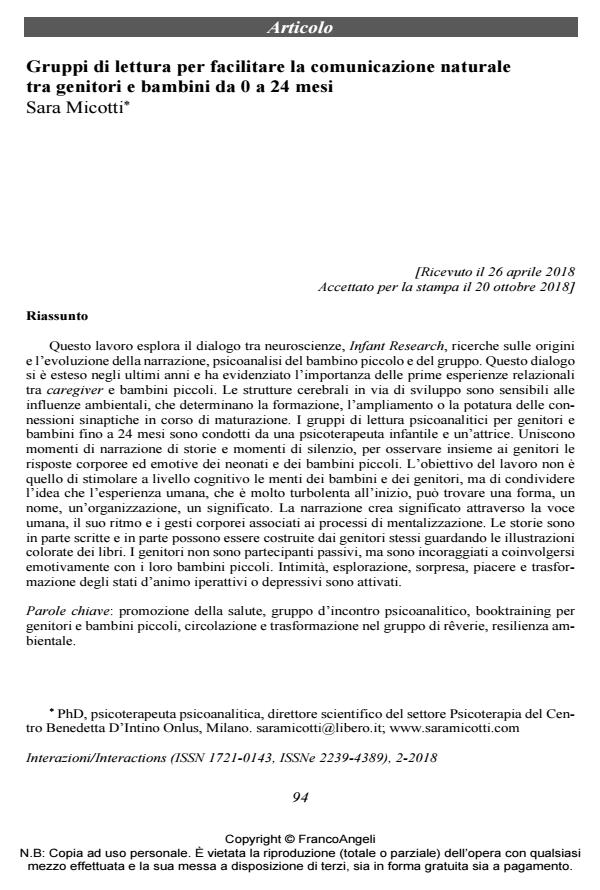Reading groups to foster emotional communication between parents and infants up to 24 months of age
Journal title INTERAZIONI
Author/s Sara Micotti
Publishing Year 2018 Issue 2018/2 Language Italian
Pages 19 P. 94-112 File size 190 KB
DOI 10.3280/INT2018-002008
DOI is like a bar code for intellectual property: to have more infomation
click here
Below, you can see the article first page
If you want to buy this article in PDF format, you can do it, following the instructions to buy download credits

FrancoAngeli is member of Publishers International Linking Association, Inc (PILA), a not-for-profit association which run the CrossRef service enabling links to and from online scholarly content.
This work explores the dialogue between neuroscience, research on the evolution of nar-rative, infant research, young children and group psychoanalysis. This has widened in recent years and highlighted the importance of early relational experiences between caregivers and infants. Developing brain structures are sensitive to environmental influences, which deter-mine the forming, the function and the pruning of synaptic connections. Psychoanalytical reading groups for parents and infants up to 24 months are set up and led by a child psycho-therapist and an actress. They combine telling stories with the observation of the bodily and emotional expressions of infants and toddlers. The idea isn’t to stimulate the minds of the young children and parents on a cognitive level, but to share the idea that human experience, which is initially turbulent, can eventually find shape, organisation and meaning. It is the shared storytelling that creates meaning through the human voice, its rhythm and bodily ges-tures associated with the mentalisation processes. The stories are partly written and partly have to be created by the parents themselves by looking at the colourful illustrations. Parents are not just passive participants but are encouraged to become emotionally engaged with their young children. Intimacy, exploration, surprise, pleasure and transformation of hyperactive or depressive moods are activated.
Keywords: Health promotion, psychoanalytic encounter group, booktraining for parents and young children, circulation and transformation of rêverie in the group, environmental resili-ence.
- Alberini C.M. (2018). Comunicazione al Convegno “Imparare a imparare: nascita della mente”, sesta giornata del Corso di Perfezionamento in Psicologia Clinica Perinatale, Università di Brescia, 10 ottobre 2018.
- Alvarez A. (2012). Un cuore che pensa. Tre livelli di terapia psicoanalitica con i bambini. Roma: Astrolabio Ubaldini, 2014.
- Basile R. (2017). Ogden visto di profilo: arte, fotografia, scrittura, fantasia e le semplici cose della vita all’origine degli interventi in seduta. Relazione letta al Convegno “È nei sogni che cominciamo davvero a vivere”, Centro Milanese di Psicoanalisi, Milano, 16 dicembre 2017
- Bion W.R. (1962). Apprendere dall’esperienza. Roma: Armando, 1972.
- Bion W.R. (1970). Attenzione e interpretazione. Roma: Armando, 1973.
- Ciavaldini A., Ruffiot A. (1999). La prima consultazione familiare e l’indicazione. Interazioni, 2: 19-26.
- Civitarese G. (2017). Trasposizioni. Milano-Udine: Mimesis.
- Collovà M. (2007). Per una psicoanalisi sostenibile. In Ferro A. (a cura di), Sognare l’analisi. Sviluppi clinici del pensiero di Bion. Torino: Bollati Boringhieri.
- Cometa M. (2017). Perché le storie ci aiutano a vivere. La letteratura necessaria. Milano: Raffaello Cortina.
- Dickinson E. (1955). Tutte le poesie (a cura di Marisa Bulgheroni). Milano: Meridiani Mondadori, 1997.
- Ferro A. (1992). La tecnica nella psicoanalisi infantile. Milano: Raffaello Cortina.
- Ferro A. (2014). Nelle viscere della mente. Milano: Raffaello Cortina.
- Gottschall J. (2012). L’istinto di narrare. Come le storie ci hanno reso umani. Torino: Boringhieri, 2014.
- Grotstein J.S. (1990). Nothingness, meaningless, chaos, and the black hole. Contemporary Psychoanalysis, 26: 377-407. DOI: 10.1080/00107530.1990.10746658
- Micotti S. (2017). Una giornata di sole. Milano: UN-GURU.
- Micotti S. (2018). Dal leggere al narrare: esperienze di ispirazione psicoanalitica con genitori e bambini da 0 a 2 anni. Comunicare, 1: 111-121.
- Murray L., Andrews L. (2000). Il linguaggio prima delle parole. Come comunicare con i neonati. Fidenza: Mattioli 1885, 2012.
- Murray L. (2014). Le prime relazioni del bambino. Milano: Raffaello Cortina.
- Neri C. (2017). Gruppo. Milano: Raffaello Cortina.
- Nicolò A.M. (2015). Dov’è collocato l’inconscio? Riflessioni sui legami nelle coppie e nelle famiglie. Interazioni, 41: 33-42. DOI: 10.3280/INT2015-001004
- Norman J. (2006). Le trasformazioni di esperienze infantili precoci: un bambino di sei mesi in psicoanalisi. L’annata psicoanalitica internazionale, 2: 131-151.
- Ogden T.H. (2005). L’arte della psicoanalisi. Sognare sogni non sognati. Milano: Raffaello Cortina, 2008.
- Panksepp J., Biven L. (2012). Archeologia della mente. Origini neuroevolutive delle emozioni umane. Milano: Raffaello Cortina, 2014.
- Riva Crugnola C. (2012). La relazione genitore-bambino. Tra adeguatezza e rischio. Bologna: Il Mulino.
- Salomonsson B. (2014). Psicoterapia psicoanalitica con bambini e genitori. Milano: Mimesis, 2016.
- Solms M. (2018). La relazione innata tra le menti. Comunicare, 1: 19-25.
- Stern D. (1985). Il mondo interpersonale del bambino. Torino: Bollati Boringhieri, 1987.
- Stern D. (1990). Diario di un bambino. Milano: Mondadori, 1991.
- Tomasello M. (2014). Unicamente umano. Storia naturale del pensiero. Bologna: Il Mulino.
- Trevarthen C. (1998). Empatia e biologia. Psicologia, cultura e neuroscienze. Milano: Raffaello Cortina.
- Tronick E. (2008). Regolazione emotiva. Milano: Raffaello Cortina.
- Winnnicott D.W. (1952). L’angoscia associata all’insicurezza. In Winnicott D.W. (1958), Dalla pediatria alla psicoanalisi. Firenze: Martinelli, 1975.
- Winnnicott D.W. (1958). Dalla pediatria alla psicoanalisi. Firenze: Martinelli, 1975
Sara Micotti, Gruppi di lettura per facilitare la comunicazione naturale tra genitori e bambini da 0 a 24 mesi in "INTERAZIONI" 2/2018, pp 94-112, DOI: 10.3280/INT2018-002008